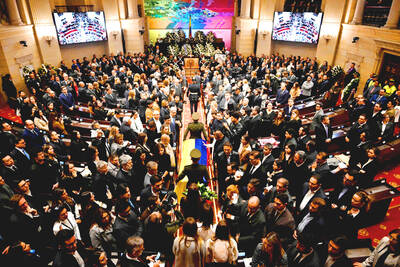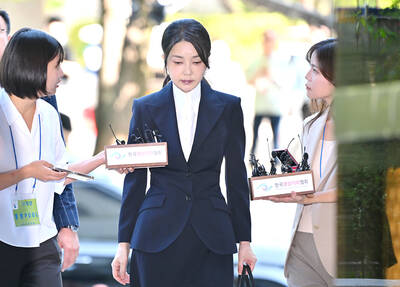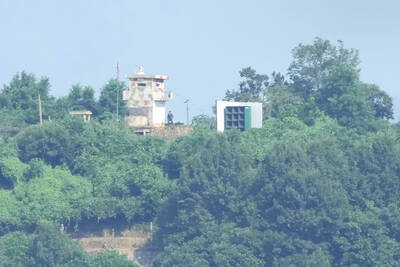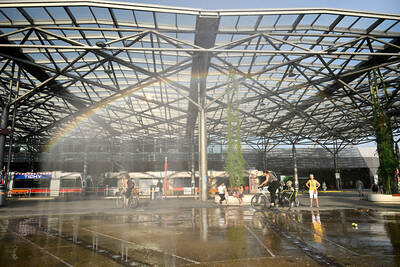At a hillside temple, a monk in saffron robes blows a refrain on a conch and begins chanting prayers as thousands of origami cranes donated to Hiroshima burn.
For a decade, the Daisho-in Buddhist temple on Miyajima Island, facing Hiroshima, has held ritual burnings of the millions of origami cranes sent to the city each year.
The ceremony is intended to honor the sentiments folded into each of the miniature paper birds.

Photo: AFP
Since 2015, the ash from the burned cranes has been used to glaze ceramic incense burners and candle holders, including one given to Ukrainian President Volodymyr Zelenskiy by Japan’s prime minister on a trip to Kyiv.
Cranes have arrived in Hiroshima for decades, inspired by Sadako Sasaki, who was two when the US dropped an atomic bomb on the city on Aug. 6, 1945.
She developed leukemia and in hospital began folding cranes in keeping with a tradition that holds that folding 1,000 can make a wish come true.
She died aged 12, one of about 140,000 people killed by the bomb immediately or in the aftermath, and has become a powerful symbol of the bomb’s effects and a popular way to educate children about the attack.
For years, the cranes sent to Hiroshima were simply left at memorials, with municipal cleaners occasionally disposing of them.
It was not until 2012, as the city searched for a better way to handle the cranes, that Kinya Saito of the Nagomi Project, a peace group, proposed ritually burning them.
“I thought about the idea of emotions being released with smoke and sent up to the victims of the atomic bomb,” the Hiroshima native said.
Yoyu Mimatsu, a monk at Daisho-in, has led the burning ceremony for the past decade.
After blowing the conch, he sits at a table in front of the fire pit and strikes a prayer bowl before beginning chants for the souls of bomb victims.
He also prays “for the emotions and prayers of people from all over the world, the prayers for peace folded into each of the paper cranes, to reach the heavens,” the 57-year-old said.
While Daisho-in was willing to burn the cranes, they were not sure what to do with the leftover ash.
They found a solution in Taigendo, a pottery studio that for more than 100 years has produced ceramics using sacred sand from under a Miyajima shrine.
The third-generation potter running the studio — Kosai Yamane — was already using ash from an eternal flame burning on Miyajima to glaze his ceramics and was open to using the crane ash in a similar way.
It was an artistic project, but also deeply personal for Yamane, whose mother was 14 at the time of the bomb attack.
“She had burn scars on her elbows, and as a child, I never saw her wear anything except long sleeves,” Yamane said.
“She never talked about it. I felt she was trying everything to avoid being noticed, to avoid talking about it,” he said.
Yamane knew immediately that the crane ash could not be used to glaze everyday items such as cups or bowls.
“I wanted to make something that would convey a message of peace from Hiroshima,” he said.
He settled first on a delicate crane-shaped incense burner, and later began producing candleholders.
They have a dome-like top modeled on the shape of the Children’s Peace Memorial and are etched with cranes. The candle sits under the dome on a plate glazed with the ash, the glaze helping reflect the light to produce a warm orange glow.
Yamane was shocked, but delighted to learn that Japanese Prime Minister Fumio Kishida had presented Zelenskiy with one on his March visit.
“I felt that people’s message of peace was in the right place,” the 60-year-old said.
“This message gathers in Hiroshima, but it does not come only from Japan, it comes from all over the world, and is brought together when the cranes are burned,” he said.
G7 leaders, including US President Joe Biden, visited peace sites in Hiroshima during last week’s summit, where Kishida pushed for action on nuclear disarmament.
“Hiroshima is now a synonym for peace,” Saito said.
It is also “a place that directly illustrates how terrifying and horrifying nuclear weapons are,” he said.
“I want the leaders to understand what happened, to listen to what people say,” he added.

‘THEY KILLED HOPE’: Four presidential candidates were killed in the 1980s and 1990s, and Miguel Uribe’s mother died during a police raid to free her from Pablo Escobar Colombian presidential candidate Miguel Uribe has died two months after being shot at a campaign rally, his family said on Monday, as the attack rekindled fears of a return to the nation’s violent past. The 39-year-old conservative senator, a grandson of former Colombian president Julio Cesar Turbay (1978-1982), was shot in the head and leg on June 7 at a rally in the capital, Bogota, by a suspected 15-year-old hitman. Despite signs of progress in the past few weeks, his doctors on Saturday announced he had a new brain hemorrhage. “To break up a family is the most horrific act of violence that

HISTORIC: After the arrest of Kim Keon-hee on financial and political funding charges, the country has for the first time a former president and former first lady behind bars South Korean prosecutors yesterday raided the headquarters of the former party of jailed former South Korean president Yoon Suk-yeol to gather evidence in an election meddling case against his wife, a day after she was arrested on corruption and other charges. Former first lady Kim Keon-hee was arrested late on Tuesday on a range of charges including stock manipulation and corruption, prosecutors said. Her arrest came hours after the Seoul Central District Court reviewed prosecutors’ request for an arrest warrant against the 52-year-old. The court granted the warrant, citing the risk of tampering with evidence, after prosecutors submitted an 848-page opinion laying out

North Korean troops have started removing propaganda loudspeakers used to blare unsettling noises along the border, South Korea’s military said on Saturday, days after Seoul’s new administration dismantled ones on its side of the frontier. The two countries had already halted propaganda broadcasts along the demilitarized zone, Seoul’s military said in June after the election of South Korean President Lee Jae-myung, who is seeking to ease tensions with Pyongyang. The South Korean Ministry of National Defense on Monday last week said it had begun removing loudspeakers from its side of the border as “a practical measure aimed at helping ease

A man has survived clinging to the outside of an Austrian high-speed train, Austria’s state railway said on Sunday, reportedly after it left while he was having a cigarette break. The man late on Saturday grabbed onto the outside of the train at St Poelten, west of Vienna, and was later taken onboard after the train performed an emergency stop, railways spokesman Herbert Hofer said. “It is irresponsible, this kind of thing usually ends up with someone dying,” he said. “And you’re not just putting yourself in danger, if you end up under the train there’s rescuers, there’s police, fire